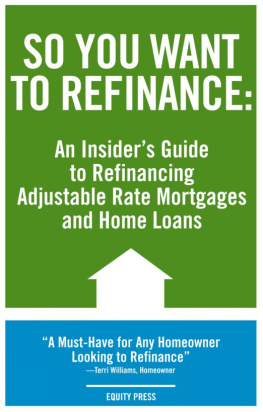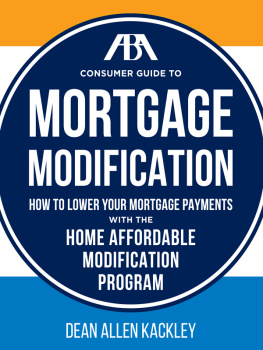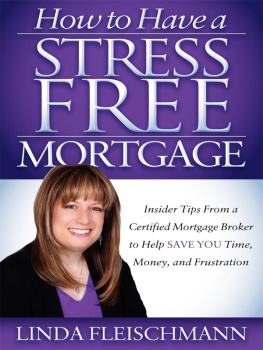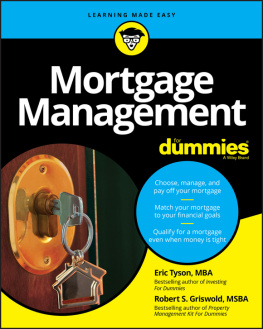Thank you for downloading this AMACOM eBook.
Sign up for our newsletter, AMACOM BookAlert , and receive special offers, access to free samples, and info on the latest new releases from AMACOM, the book publishing division of American Management Association.
To sign up, visit our website: www.amacombooks.org
To learn more about the American Management Association visit: www.amanet.org

The copyright information for this title may be found at the end of this eBook file.
MORTGAGES
MORTGAGES
Quick Answers to Over
250 Critical Questions
About Your Home Loan
THIRD EDITION
David Reed

CONTENTS
SECTION I
MORTGAGE FUNDAMENTALS
CHAPTER 1
INTRODUCTION TO MORTGAGES
CHAPTER 2
HOW TO KNOW HOW MUCH HOME TO BUY
CHAPTER 3
GETTING YOUR FINANCES TOGETHER
CHAPTER 4
DOWN PAYMENTS AND HOW THEY IMPACT YOUR MORTGAGE
CHAPTER 5
GETTING YOUR CREDIT TOGETHER
CHAPTER 6
CREDIT SCORES: WHAT THEY ARE, HOW THEY WORK, AND HOW TO IMPROVE THEM
SECTION II
THE RIGHT MORTGAGE
CHAPTER 7
FINDING YOUR HOME LOAN
CHAPTER 8
LOANS FOR GOOD TO GREAT CREDIT
CHAPTER 9
REFINANCING AND HOME EQUITY LOANS
CHAPTER 10
CONSTRUCTION AND HOME IMPROVEMENT LOANS
SECTION III
THE RIGHT LENDER AND RATE
CHAPTER 11
FINDING THE BEST LENDER
CHAPTER 12
FINDING THE BEST LOAN OFFICER
CHAPTER 13
FINDING THE BEST INTEREST RATE
CHAPTER 14
CLOSING COSTS AND HOW TO SAVE ON THEM
CHAPTER 15
USING THE INTERNET THE RIGHT WAY
APPENDIX
MONTHLY PAYMENT SCHEDULES
Preface
With more than 20 years in mortgage lending, counseling home buyers from New York to California, Ive certainly seen it all. The first edition of this book, published back in 2004, helped thousands understand, in plain English, the home loan process. Its a confusing industry, mortgage lending. Heck, even the name sounds a little funny. And speaking of, the word itself has two roots with origins in both Latin and Old French. Literally its translated as dead pledge. Sounds fun, doesnt it? But by reading this book, you will find some fun explanations on how mortgage loans are approved and learn about the differences in home loan programs. We bust a few myths along the way, as well.
The second edition was published in 2008. You remember that time, dont you? Or maybe you erased it from your mind, just like mortgage companies and no document loans were erased from the industry. The old joke was that all lenders did leading up to 2008 was to make sure someone could fog up a mirror, and if there wasnt any fog theyd make an exception. It wasnt very fun being in the mortgage business back then. A lot of loan programs simply vanished almost overnight along with the lenders who made them.
The backlash was almost immediate. While it was too easy to get a mortgage loan for years with little regard for risk, suddenly it was nearly impossible to get a mortgage. Lending guidelines tightened up so fast that many mortgage companies simply appeared to be too afraid to approve a loan application, thinking theyd have to buy it back later due to some sort of compliance or documentation issue.
Slowly, however, the industry returned to its commonsense roots. Yet the mortgage landscape today looks different compared to just a few years ago. Congress stepped in and amended the Home Ownership and Equity Protection Act, first passed in 1994. The amendments took effect in 2009 and lenders are approving loans in a brand-new world. But theyre getting much better at it. In fact, loan quality today rivals any other period in recent memory. Mortgage lenders are approving loans for those with a job, verifiable income, decent credit, and enough money in the bank to close on a home purchase. These same standards apply to anyone refinancing an existing loan as well.
But for those who are thinking of buying their first home, they may also carry no shortage of anxiety. After all, will another financial meltdown happen yet again? This trepidation is certainly understandable and in fact healthy. However, loans being approved today are being evaluated in ways that make sure those who apply for a mortgage loan are in the right loan program, can comfortably afford their monthly payments each month, and that the mortgage company follows proper lending guidelines throughout the loan approval process.
What remain today are the stalwarts of mortgage lending, yet with a whole new set of rules. And with this new set of rules, combined with traditional guidelines and protocol, come new questions, new scenarios, and a host of compliance issues.
Yet by reading this book, and referring to it as you move through the approval process, youll know more about the mortgage industry than many of the loan officers out there. Ive been where you are now and I know how the industry works and I know the questions you might have. In fact, the answers to more than 250 of them are in your very hands.
David Reed
SECTION 1

MORTGAGE FUNDAMENTALS

CHAPTER 1
Introduction to Mortgages
Theres a lot more to buying a home than just picking one out and moving in. If you dont have a wad of cash stuffed in your sofa cushions, chances are youll need a mortgage. Mortgage lending has been around for a long, long time, and some things havent changed, while other parts of the mortgage process are brand new. Knowing what youre getting into can help you to make the right decisions.
1.1 HOW HAS THE MORTGAGE MARKET CHANGED SINCE THE LAST EDITION OF MORTGAGES 101?
Wow. A lot, and thats what well be covering in this new third edition. Yet we appear to have come somewhat full circle dating back to 2004 when the first Mortgages 101 was published. Its really been interesting to watch, and very much so if you follow the mortgage market like I do.
TELL ME MORE
If we go back to 2004 and look at the mortgage market then, it was made primarily of two classes of mortgage loans, conventional and government-backed. Conventional loans are those underwritten to standards issued by Fannie Mae and Freddie Mac, while government-backed loans are those carrying a government guarantee and include .
Yet the subprime mortgage market was just getting started. Subprime loans, mortgages issued to those with damaged credit, began to enter the mortgage market with swagger. Lenders made a lot of money with subprime loans and soon new lenders entered the market going after the subprime borrower. Within a few years of this overheating subprime market, the foreclosure crisis began and lenders mostly stopped lendingat least those who were still in business.
Next page



















